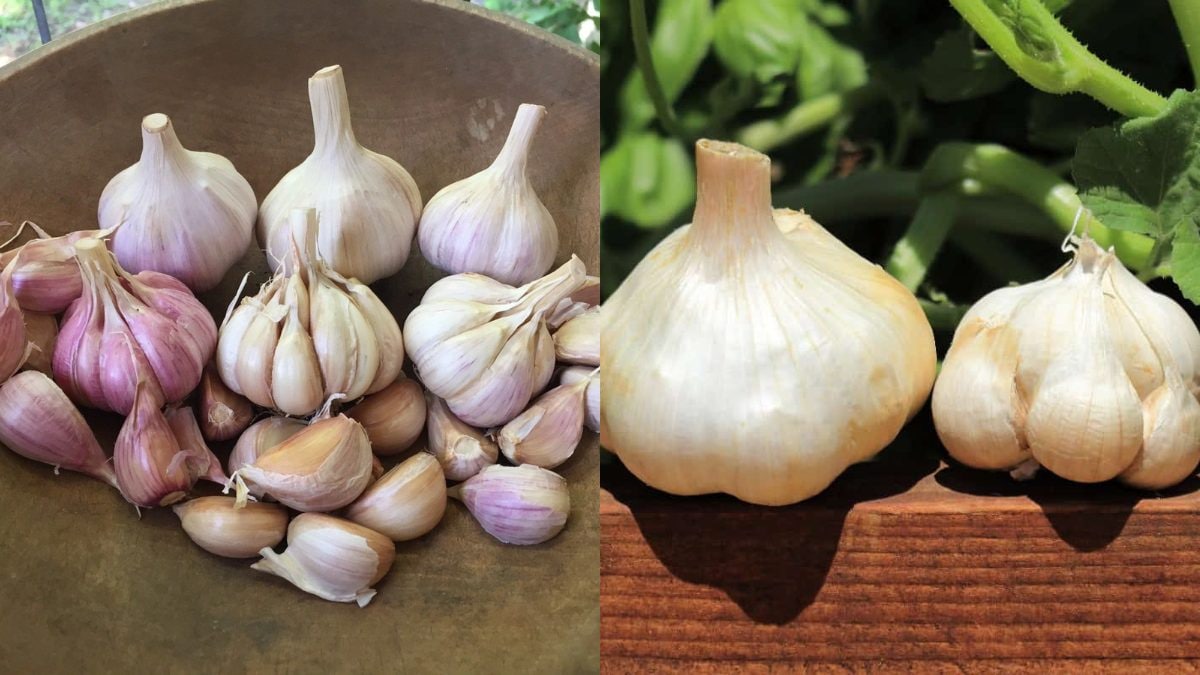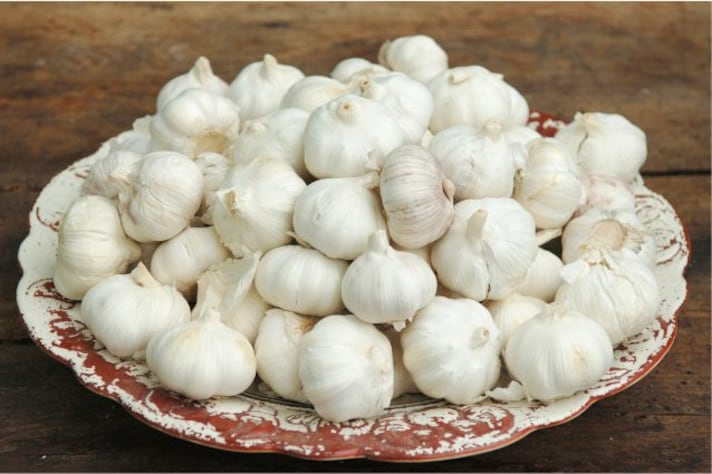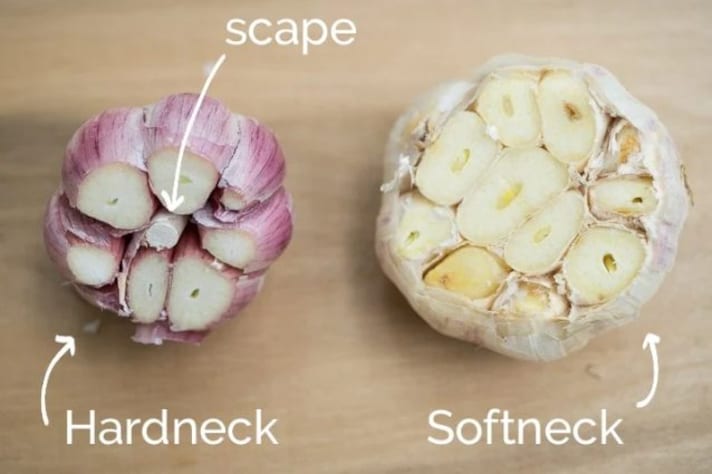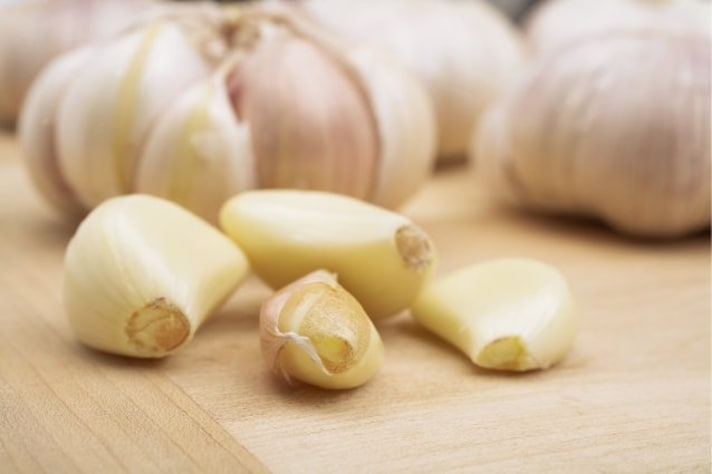
Garlic—one of the kitchen’s most versatile and pungent power players. If you’ve ever wandered through a grocery store or strolled through a farmer’s market, you’ve probably seen those plump, white bulbs sitting next to each other. But what exactly makes softneck and hardneck garlic distinct, and which one should you grab for your next recipe?
The Seed Story: Softneck vs. Hardneck
The first difference between softneck and hardneck garlic lies in their reproductive methods. While both are varieties of Allium sativum, they grow and spread differently.
Softneck garlic, as the name suggests, has a more flexible neck. This type of garlic doesn’t produce seeds. Instead, it reproduces through tiny bulbs called bulbils, which form at the top of the garlic stalk. Bulbils are planted to grow new bulbs, making softneck garlic a more straightforward variety to propagate. This is the type you’ll most commonly find in the grocery store.
Hardneck garlic, on the other hand, has a stiff, central stem or “scape” that emerges from the bulb. Unlike softneck garlic, hardneck garlic produces seeds and bulbils. The presence of this central stalk is why hardneck varieties are often seen as more rustic and flavorful. This also means that hardneck garlic tends to have a shorter shelf life, but it’s the true choice for those looking to grow garlic at home and harvest seeds.

Taste Test: A Flavor Faceoff
Softneck garlic tends to have a milder, sweeter taste. This makes it a better option for everyday cooking, where you want the garlic to blend in with other ingredients without overwhelming the dish. Its milder flavor also makes it a perfect fit for preserved garlic, like garlic powder or garlic salt, since the subtlety shines through in these products.
Hardneck garlic, however, brings more punch. It has a spicier, more complex flavor that tends to stand out more in dishes. The taste of hardneck garlic can be described as bold and somewhat fiery, often with a hint of bitterness. This makes it a great choice for more intense dishes where garlic is the star, such as garlic butter, roasted meats, or a garlic-infused oil.
Bulb Breakdown: Softneck vs. Hardneck Heads
The differences between these two types of garlic are readily apparent when you break them open. Softneck garlic bulbs typically consist of more, smaller cloves that are packed tightly together. These bulbs have a smooth, easily removable skin, which makes them easy to store and peel. You’ll often see softneck garlic in large supermarket chains because it’s less prone to damage and has a longer shelf life, making it ideal for shipping and long-term storage.

On the flip side, hardneck garlic bulbs are often larger and have fewer, but bigger cloves. The structure of the bulb is less uniform, which makes it somewhat more fragile compared to softneck. Hardneck garlic also has a distinct central stalk running through the bulb, which softneck garlic lacks. When you roast hardneck garlic, those larger cloves tend to become caramelized and tender, making them a perfect choice for adding depth to your dishes.
Cooking with Softneck vs. Hardneck Garlic
Softneck garlic is a fantastic all-purpose option. It’s often used in everyday cooking for things like pasta sauces, stir-fries, and garlic bread. The mild flavor of softneck garlic works well when it’s cooked, as it doesn’t overpower the other ingredients in a dish. Additionally, softneck garlic is often used in preserved forms, such as garlic powder, since its milder taste holds up well in these types of preparations.
Hardneck garlic, however, is often the favorite in high-heat cooking methods like roasting. The cloves of hardneck garlic caramelize beautifully, creating a sweetness and depth of flavor that’s perfect for mashed potatoes, soups, or drizzling over roasted vegetables. Its robust taste can stand up to the boldest of dishes—think garlic butter for steaks or roasted garlic mashed potatoes. If you’re using garlic raw, like in salsas or dressings, hardneck garlic can offer a more pungent kick.
Which Garlic Should You Grow?
For most home gardeners, hardneck garlic is an ideal choice, particularly if you live in colder climates. Hardneck varieties do best in regions with a true winter season, as they require a period of cold to produce the best bulbs. These types tend to offer a more robust flavor and are often prized by garlic aficionados.
However, if you live in a warmer climate, softneck garlic might be a better fit. It thrives in areas with milder winters and is often easier to grow. It also has the advantage of longer storage, meaning you can keep your garlic for months after harvest.

Grocery Store Garlic: Which One Are You Buying?
If you’re picking up garlic at your local grocery store, it’s almost always going to be softneck garlic. The convenience, shelf stability, and ease of storage make it the go-to for large-scale distribution. You’ll find it pre-peeled, in bags, or even as a bulb with the typical smooth white skin.
While you can sometimes find hardneck garlic at farmer’s markets or specialty grocery stores, it’s less common in mass-market grocery stores due to its shorter shelf life and smaller yield per bulb. Hardneck garlic tends to be more expensive and is often bought by those who appreciate its bold flavor and plan to use it in specific culinary applications.
Chefs’ Garlic Preference
When it comes to professional kitchens, chefs often lean toward hardneck garlic for its flavor. The intensity and complexity of hardneck garlic make it the preferred choice for dishes where garlic’s flavor needs to shine through. Chefs especially love the larger cloves for roasting and for incorporating into dishes where the garlic needs to stand out.
That said, softneck garlic is still widely used in many professional kitchens, particularly for day-to-day tasks like mincing or incorporating into sauces and soups. Its milder taste and greater availability make it a reliable, versatile option that chefs can use in bulk.